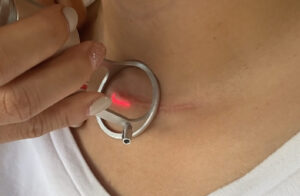In the world of aesthetic medicine and dermatology, the CO2 fractional laser has emerged as a revolutionary technology for non-surgical skin treatments. Offering a perfect balance of effectiveness and safety, it has become a go-to solution for skin resurfacing, scar reduction, wrinkle smoothing, and more. But behind the success of every CO2 fractional laser system lies the crucial role of the laser handpiece and its control system, which determine treatment precision, safety, and outcomes.
What Is a CO2 Fractional Laser?
A CO2 fractional laser is an advanced medical laser that uses carbon dioxide (CO2) as its active medium. It emits infrared light at a wavelength of 10,600 nanometers, which is highly absorbed by water in the skin tissue. This makes it an ideal tool for ablative skin resurfacing, where microscopic columns of skin are removed to stimulate natural healing and collagen production.
Unlike traditional CO2 lasers that treated the entire surface of the skin, fractional CO2 lasers treat fractional zones of the skin by creating an array of tiny thermal injuries while leaving the surrounding tissue intact. This “fractional” approach significantly reduces recovery time and side effects while maintaining excellent clinical results.
Key Applications of CO2 Fractional Laser
- Skin Rejuvenation and Wrinkle Reduction
One of the most common uses of CO2 fractional laser is in anti-aging treatments. By ablating damaged skin layers and stimulating new collagen growth, it effectively reduces the appearance of fine lines and deep wrinkles, especially around the eyes, mouth, and forehead. - Acne Scar and Surgical Scar Treatment
The precision of fractional lasers makes them excellent for acne scar revision. They can break down scar tissue and promote smoother skin regeneration. Similarly, they are used to treat surgical and traumatic scars, offering visible improvement after just a few sessions.
- Skin Tightening and Pore Minimization
CO2 fractional lasers can tighten loose or sagging skin by boosting collagen production. Many patients report smaller pores and firmer skin texture following treatments. - Stretch Mark and Pigmentation Treatment
Stretch marks, often considered difficult to treat, can be improved with CO2 fractional lasers. The laser stimulates dermal remodeling to reduce the appearance of striae. In addition, pigmentation issues such as melasma or age spots can also be addressed by selectively removing pigmented skin layers. - Gynecological Applications
Beyond dermatology, CO2 fractional lasers are increasingly used in gynecology for procedures such as vaginal rejuvenation, helping treat issues like dryness, laxity, and mild urinary incontinence.
The Importance of Laser Handpieces
At the heart of the CO2 fractional laser’s performance is the laser handpiece—a precision instrument that delivers laser energy from the source to the skin. High-quality handpieces are designed with multiple scanning patterns, spot sizes, and energy settings to adapt to different treatment areas and skin types.
The scanning mode and pattern (such as spiral, linear, or random) play a key role in controlling thermal damage and treatment efficiency. Handpieces with advanced optics and galvanometer scanning systems allow for extremely precise control over depth, spacing, and density, ensuring consistent treatment results with minimal risk.
Ergonomic design is another factor that contributes to treatment success. A lightweight, well-balanced handpiece reduces operator fatigue and enhances accuracy, especially during long or delicate procedures.
Advanced Control Systems: Ensuring Safety and Customization
Behind every successful laser treatment is a robust and intelligent control system. The control system governs:
- Pulse duration and energy levels
- Spot size and treatment depth
- Scan speed and pattern
- Cooling systems and safety interlocks
Modern CO2 fractional lasers feature touchscreen interfaces and pre-programmed treatment protocols, allowing practitioners to quickly adjust settings based on the treatment area (e.g., face, neck, chest, or vaginal tissue) and patient condition. This level of customization ensures optimal results with minimized downtime.
Furthermore, integration with real-time feedback systems ensures that energy delivery is consistent and safe, reducing the risk of burns or overtreatment.
CO2 Fractional Laser in Clinics: A Smart Investment
For aesthetic clinics, investing in a reliable CO2 fractional laser system with a high-performance handpiece and intelligent control system can significantly expand their service offerings. These systems offer:
- High patient satisfaction
- Short recovery periods
- Versatile treatment capabilities
- Long-term revenue potential
Whether used as a standalone solution or combined with PRP (platelet-rich plasma) or RF microneedling, CO2 fractional laser treatments continue to draw attention for their effectiveness and adaptability.
Conclusion
The CO2 fractional laser is a transformative tool in the field of medical aesthetics, offering safe and effective treatment for a wide range of skin conditions. However, its success doesn’t rely solely on laser energy—it depends heavily on the precision of the laser handpiece and the flexibility of the control system.
As technology evolves, so too does the need for smarter, safer, and more ergonomic devices that can deliver predictable results. For patients and practitioners alike, understanding the integral components of a CO2 fractional laser system is key to making informed decisions and achieving the best outcomes.

